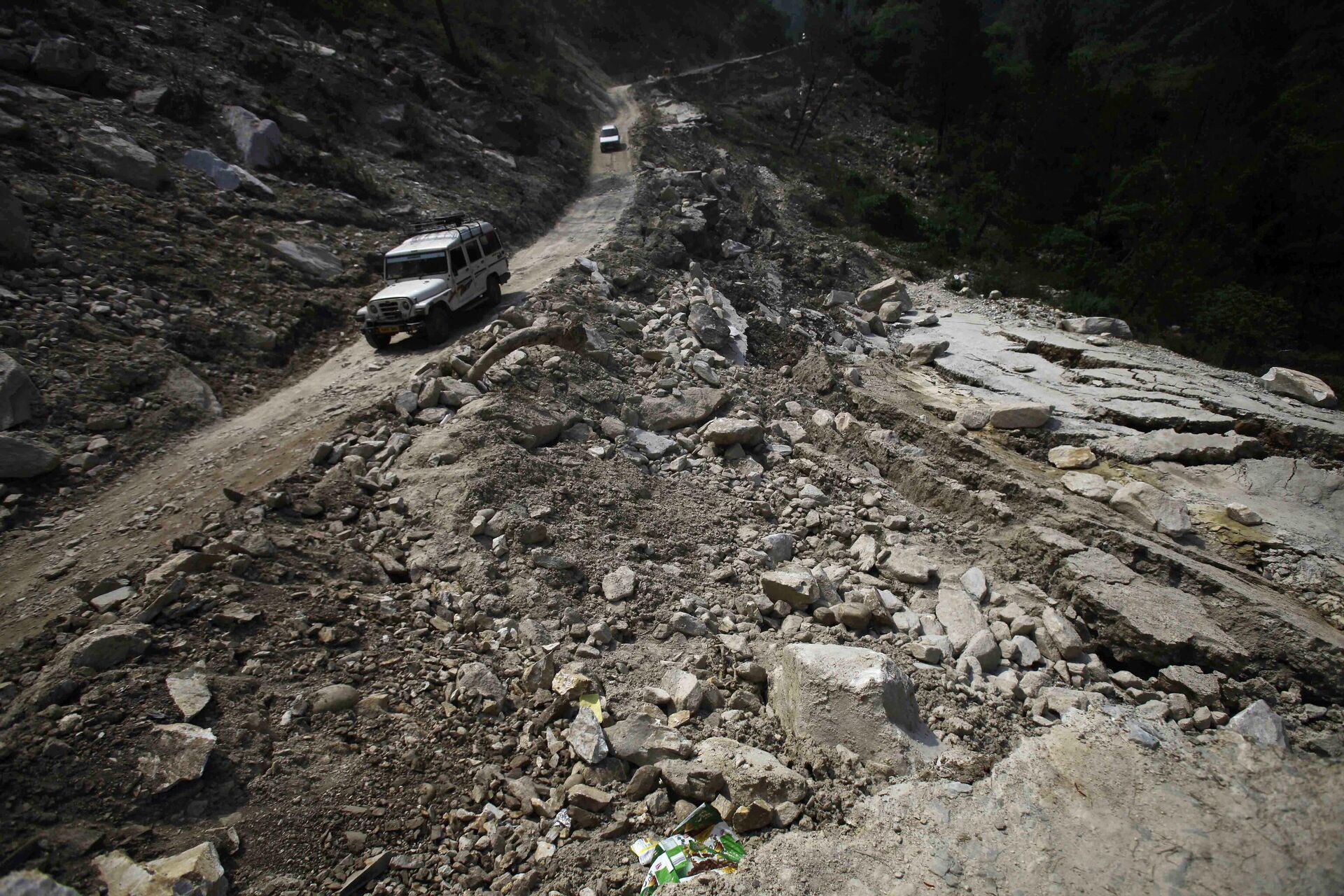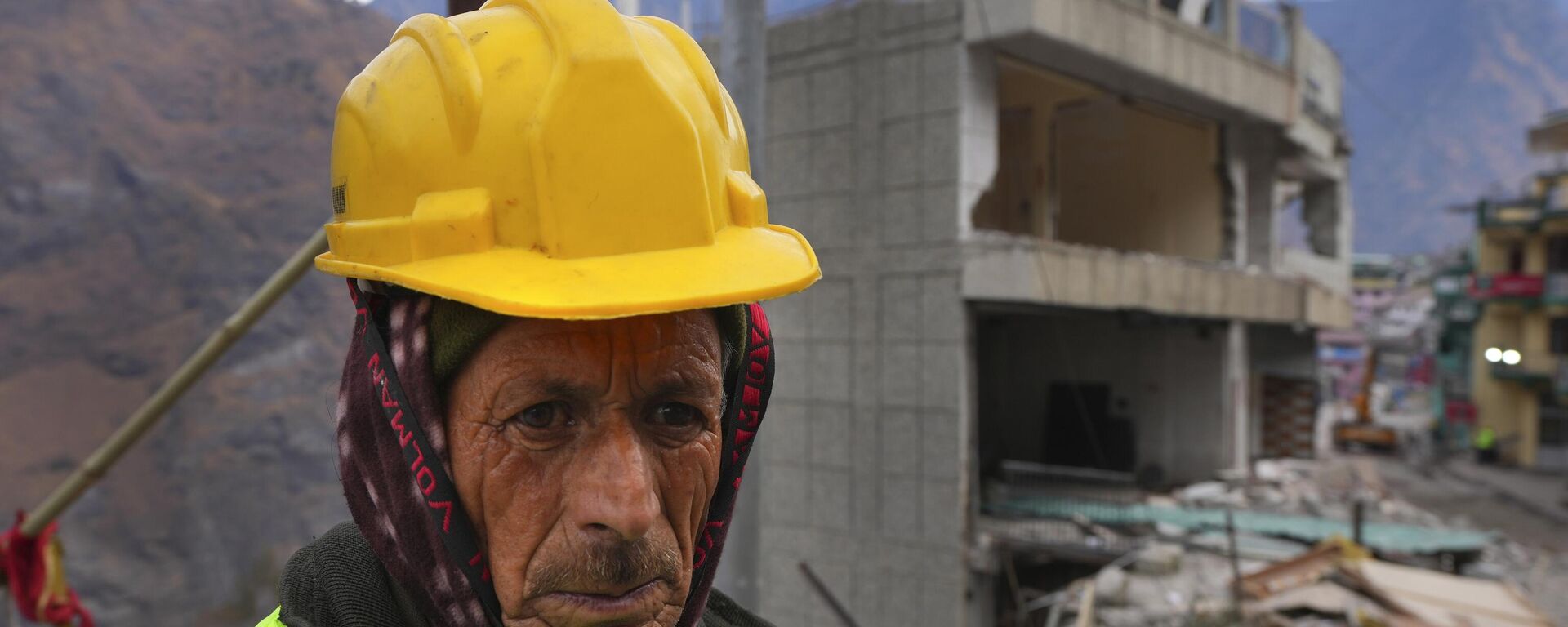https://sputniknews.in/20230926/sinking-town-joshimath-prone-to-high-magnitude-earthquakes-expert-says-4436241.html
'Sinking Town' Joshimath Prone to High-Magnitude Earthquakes, Expert Says
'Sinking Town' Joshimath Prone to High-Magnitude Earthquakes, Expert Says
Sputnik India
Since December last year, several regions including Joshimath, Karnaprayag and others in the hilly state of Uttarakhand witnessed deep cracks on roads and buildings due to land subsidence, forcing residents to relocate to safer zones.
2023-09-26T09:02+0530
2023-09-26T09:02+0530
2023-09-26T09:02+0530
india
uttarakhand
joshimath
sinking land
landslide
the himalayas
disaster relief
national disaster response force (ndrf)
natural disaster
https://cdn1.img.sputniknews.in/img/07e7/01/0a/436842_0:200:2931:1849_1920x0_80_0_0_1624303ed8b5eace1bc502d95e44405b.jpg
A comprehensive report by eight government-run institutes has been released, revealing that the "sinking town" of Joshimath in the hilly state of Uttarakhand is prone to powerful earthquakes due to a series of devastating land subsidences and quakes forcing people to leave their town. The report comes days after the Uttarakhand High Court questioned the state government's decision to not make the reports by the experts public. Ranjit Sinha, secretary of Uttarakhand Disaster Management Department, said in the report that all the construction in the high-risk zone in Joshimath will be demolished. Joshimath has been divided into four zones - red, black, yellow, and green - according to the report. These zones are determined based on the magnitude of danger from land subsidence, which refers to the sinking or settling of the ground surface. The residents had previously sent a letter to Uttarakhand state chief, Pushkar Singh Dhami, regarding the explosions in the NTPC project tunnels. However, the company had firmly rejected any connection between their project and the situation in Joshimath.The experts blamed the crisis on unplanned and chaotic infrastructure projects in the region, especially a power plant that involved blasts and drilling in the mountains.The eight government-run institutes tasked with assessing the sinking of the ground surface in Joshimath include the Central Building Research Institute, Geological Survey of India, Wadia Institute of Himalayan Geology, National Geophysical Research Institute, Central Ground Water Board, Indian Institute of Remote Sensing, and National Institute of Hydrology and IIT.What is Joshimath Famous For?Joshimath was built on the slopes of old landslides. It became famous as the place where religious reformer Adi Shankaracharya attained enlightenment in the eighth century.Situated just 50 km away from India's border with China, Joshimath is a gateway to highly revered religious Hindu shrines Badrinath and Hemkund Sahib, and to a number of Himalayan mountain climbing expeditions and trekking trails.
https://sputniknews.in/20230512/joshimath-land-subsidence-victims-protest-govts-failure-to-tackle-issues-1919918.html
india
uttarakhand
joshimath
the himalayas
Sputnik India
feedback.hindi@sputniknews.com
+74956456601
MIA „Rossiya Segodnya“
2023
Sangeeta Yadav
https://cdn1.img.sputniknews.in/img/07e6/0c/0f/110602_0:0:641:640_100x100_80_0_0_c298016a79eb02ef8caa9d1f688c12a5.jpg
Sangeeta Yadav
https://cdn1.img.sputniknews.in/img/07e6/0c/0f/110602_0:0:641:640_100x100_80_0_0_c298016a79eb02ef8caa9d1f688c12a5.jpg
News
en_IN
Sputnik India
feedback.hindi@sputniknews.com
+74956456601
MIA „Rossiya Segodnya“
Sputnik India
feedback.hindi@sputniknews.com
+74956456601
MIA „Rossiya Segodnya“
Sangeeta Yadav
https://cdn1.img.sputniknews.in/img/07e6/0c/0f/110602_0:0:641:640_100x100_80_0_0_c298016a79eb02ef8caa9d1f688c12a5.jpg
joshimath, karnaprayag, hilly state, uttarakhand, deep cracks on roads, land subsidence, comprehensive report, eight government-run institutes, "sinking town", joshimath, earthquakes, land subsidence, quakes, uttarakhand high court, ranjit sinha, secretary of uttarakhand disaster management department, high-risk zone, danger, uttarakhand state chief, pushkar singh dhami, ntpc project tunnels, central building research institute, geological survey of india, wadia institute of himalayan geology, national geophysical research institute, central ground water board, indian institute of remote sensing, national institute of hydrology, iit, landslides, religious reformer, adi shankaracharya, enlightenment, border with china, hindu shrines, badrinath, hemkund sahib, himalayas
joshimath, karnaprayag, hilly state, uttarakhand, deep cracks on roads, land subsidence, comprehensive report, eight government-run institutes, "sinking town", joshimath, earthquakes, land subsidence, quakes, uttarakhand high court, ranjit sinha, secretary of uttarakhand disaster management department, high-risk zone, danger, uttarakhand state chief, pushkar singh dhami, ntpc project tunnels, central building research institute, geological survey of india, wadia institute of himalayan geology, national geophysical research institute, central ground water board, indian institute of remote sensing, national institute of hydrology, iit, landslides, religious reformer, adi shankaracharya, enlightenment, border with china, hindu shrines, badrinath, hemkund sahib, himalayas
'Sinking Town' Joshimath Prone to High-Magnitude Earthquakes, Expert Says
Since December last year, several regions, including Joshimath, Karnaprayag, and others in the hilly state of Uttarakhand, have witnessed deep cracks on roads and buildings due to land subsidence, forcing residents to relocate to safer zones.
A comprehensive report by eight government-run institutes has been released, revealing that the "sinking town" of Joshimath in the hilly state of Uttarakhand is prone to powerful earthquakes due to a series of devastating land subsidences and quakes forcing people to leave their town.
The report comes days after the Uttarakhand High Court questioned the state government's decision to not make the reports by the experts public.
Ranjit Sinha, secretary of Uttarakhand Disaster Management Department, said in the report that all the construction in the high-risk zone in Joshimath will be demolished.
Joshimath has been divided into four zones - red, black, yellow, and green - according to the report. These zones are determined based on the magnitude of danger from
land subsidence, which refers to the sinking or settling of the ground surface.
The residents had previously sent a letter to Uttarakhand state chief, Pushkar Singh Dhami, regarding the explosions in the NTPC project tunnels. However, the company had firmly rejected any connection between their project and the situation in Joshimath.
The experts blamed the crisis on unplanned and chaotic infrastructure projects in the region, especially a power plant that involved blasts and drilling in the mountains.
The eight government-run institutes tasked with assessing the sinking of the ground surface in Joshimath include the
Central Building Research Institute, Geological Survey of India, Wadia Institute of Himalayan Geology, National Geophysical Research Institute, Central Ground Water Board, Indian Institute of Remote Sensing, and National Institute of Hydrology and IIT.What is Joshimath Famous For?
Joshimath was built on the slopes of old landslides. It became famous as the place where religious reformer Adi Shankaracharya attained enlightenment in the eighth century.
Situated just 50 km away from India's border with
China, Joshimath is a gateway to highly revered religious Hindu shrines Badrinath and Hemkund Sahib, and to a number of Himalayan mountain climbing expeditions and trekking trails.




